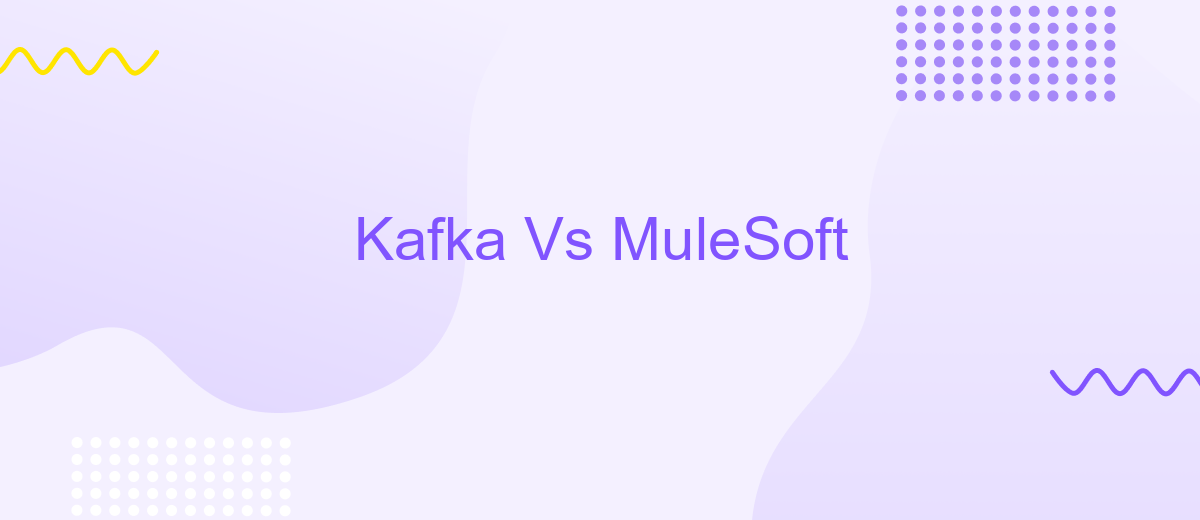Kafka Vs MuleSoft
In the evolving landscape of data integration and real-time processing, Kafka and MuleSoft stand out as powerful tools with distinct capabilities. Kafka, a high-throughput distributed messaging system, excels in real-time data streaming, while MuleSoft, an integration platform, offers extensive connectivity and API management. This article delves into their features, strengths, and use cases to help you choose the right solution for your needs.
Introduction
In today's rapidly evolving digital landscape, businesses are increasingly relying on robust integration platforms to streamline their operations and enhance communication between various systems. Two prominent solutions in this domain are Kafka and MuleSoft, each offering unique capabilities to address diverse integration needs.
- Kafka: An open-source stream-processing platform designed for handling real-time data feeds.
- MuleSoft: A comprehensive integration platform that provides tools for connecting applications, data, and devices.
Choosing the right integration solution depends on various factors such as scalability, ease of use, and specific business requirements. While Kafka excels in handling large volumes of real-time data, MuleSoft offers a more extensive suite of tools for integrating a wide range of systems. Additionally, services like ApiX-Drive can further simplify the integration process by providing user-friendly interfaces and automation capabilities, making it easier for businesses to connect disparate systems seamlessly.
Key Concepts and Features

Kafka is a distributed streaming platform designed for high-throughput, fault-tolerant, and scalable data processing. It excels in real-time data streaming, event sourcing, and log aggregation. Key features include message durability, horizontal scalability, and low-latency message delivery. Kafka's architecture is based on a publish-subscribe model, allowing multiple producers and consumers to interact seamlessly. With its robust ecosystem, including Kafka Streams and Kafka Connect, it integrates well with various data sources and sinks, making it a popular choice for real-time analytics and microservices architectures.
MuleSoft, on the other hand, is an integration platform that enables seamless connectivity between diverse applications, data sources, and APIs. Its core component, Anypoint Platform, provides tools for API design, management, and monitoring. MuleSoft's DataWeave language simplifies data transformation, while its pre-built connectors facilitate integration with numerous systems. For businesses looking to streamline their integration processes, services like ApiX-Drive can further enhance MuleSoft’s capabilities by automating data flows between applications, reducing manual effort, and ensuring data consistency across platforms.
Comparison of Capabilities

When comparing Kafka and MuleSoft, it is essential to consider their unique capabilities and how they cater to different integration needs. Kafka is renowned for its high-throughput, low-latency platform designed for real-time data streaming. MuleSoft, on the other hand, excels in providing a comprehensive integration platform that supports a wide range of protocols and connectors for seamless application and data integration.
- Data Streaming: Kafka handles large-scale data streaming efficiently, making it ideal for real-time analytics and event-driven architectures.
- Integration: MuleSoft offers extensive integration capabilities with numerous pre-built connectors, simplifying the process of connecting disparate systems.
- Scalability: Kafka's distributed architecture allows for easy scalability, handling high volumes of data with minimal latency.
- Flexibility: MuleSoft's Anypoint Platform provides flexibility through API-led connectivity, enabling organizations to adapt quickly to changing business needs.
- Ease of Use: Tools like ApiX-Drive can further simplify integration processes, offering user-friendly interfaces and automation features to streamline workflows.
In conclusion, Kafka is ideal for scenarios requiring robust data streaming capabilities, while MuleSoft is more suited for comprehensive integration needs across various systems. Depending on the specific requirements of a project, either platform could be the better choice, with tools like ApiX-Drive enhancing the integration experience.
Use Cases and Industry Applications

Apache Kafka and MuleSoft serve distinct purposes in the realm of data integration and real-time processing. Kafka excels in handling high-throughput data streams, making it ideal for scenarios requiring real-time analytics and event-driven architectures. On the other hand, MuleSoft is a robust integration platform that facilitates seamless connectivity between various applications, data, and devices, ensuring smooth data flow across enterprise ecosystems.
Many industries leverage these technologies to meet their specific needs. For instance, Kafka is widely used in financial services for fraud detection and in telecommunications for monitoring network performance. MuleSoft, with its comprehensive API management capabilities, is prevalent in healthcare for integrating patient data from disparate systems and in retail for unifying customer experiences across channels.
- Financial Services: Real-time fraud detection with Kafka
- Telecommunications: Network performance monitoring using Kafka
- Healthcare: Integrating patient data through MuleSoft
- Retail: Enhancing customer experience with MuleSoft
For businesses looking to streamline their integrations, tools like ApiX-Drive offer valuable solutions. ApiX-Drive simplifies the process of connecting various services and automating workflows, making it easier for organizations to leverage the strengths of both Kafka and MuleSoft in their operations.
Conclusion
In conclusion, both Kafka and MuleSoft offer robust solutions for integration and data streaming, each with its unique strengths. Kafka excels in real-time data processing and is ideal for high-throughput, event-driven architectures. On the other hand, MuleSoft provides a comprehensive integration platform that supports a wide range of connectors and is particularly strong in API management and orchestrating complex business processes.
Choosing between Kafka and MuleSoft ultimately depends on your specific use case and requirements. For organizations seeking a versatile integration solution with extensive pre-built connectors, MuleSoft is a strong contender. However, for scenarios demanding high-performance data streaming and real-time analytics, Kafka is often the preferred choice. Additionally, services like ApiX-Drive can further enhance your integration capabilities by offering easy-to-use tools for connecting various applications and automating workflows, making the integration process smoother and more efficient.
- Automate the work of an online store or landing
- Empower through integration
- Don't spend money on programmers and integrators
- Save time by automating routine tasks
FAQ
What are the main differences between Kafka and MuleSoft?
Can Kafka and MuleSoft be used together?
Which platform is better for real-time data processing?
How do Kafka and MuleSoft handle scalability?
What are the typical use cases for Kafka and MuleSoft?
Apix-Drive is a simple and efficient system connector that will help you automate routine tasks and optimize business processes. You can save time and money, direct these resources to more important purposes. Test ApiX-Drive and make sure that this tool will relieve your employees and after 5 minutes of settings your business will start working faster.


